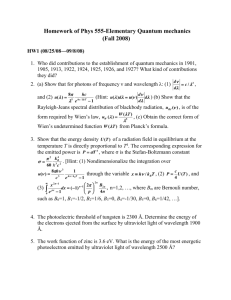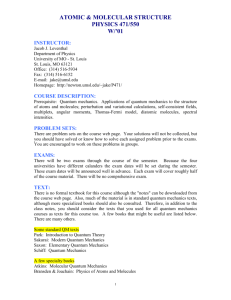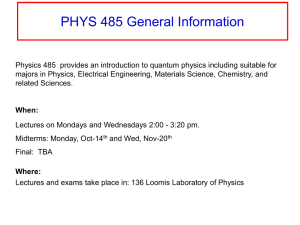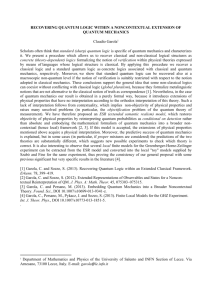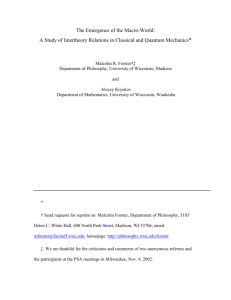Homework of Phys 621-Quantum mechanics I (Fall 2007)
advertisement
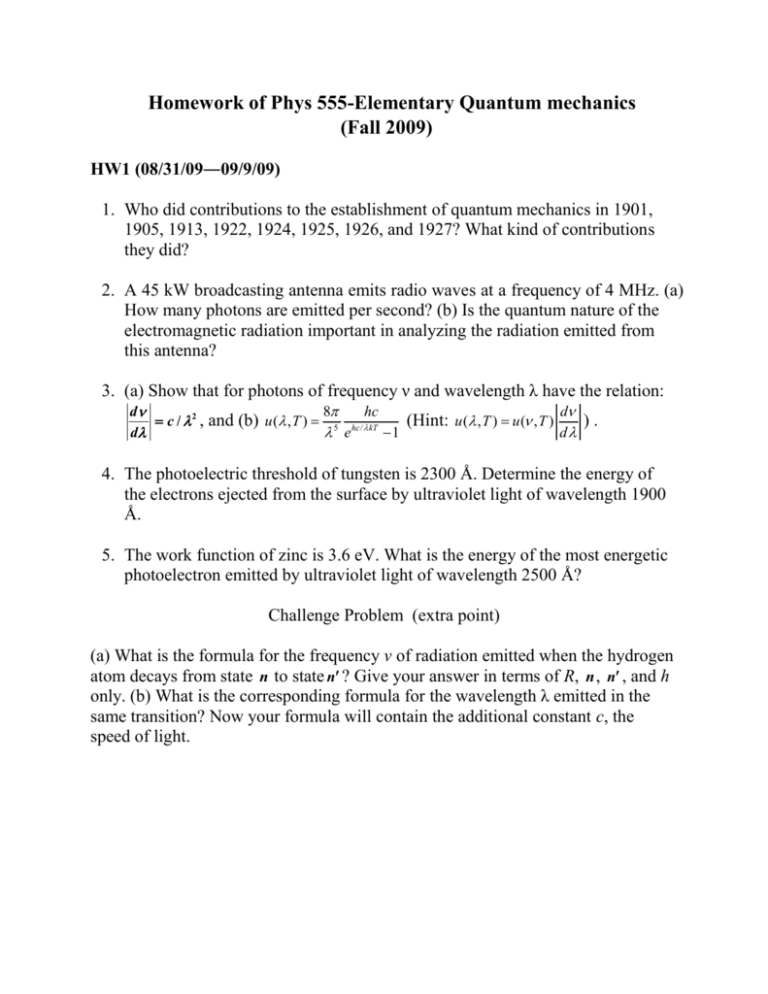
Homework of Phys 555-Elementary Quantum mechanics
(Fall 2009)
HW1 (08/31/09―09/9/09)
1. Who did contributions to the establishment of quantum mechanics in 1901,
1905, 1913, 1922, 1924, 1925, 1926, and 1927? What kind of contributions
they did?
2. A 45 kW broadcasting antenna emits radio waves at a frequency of 4 MHz. (a)
How many photons are emitted per second? (b) Is the quantum nature of the
electromagnetic radiation important in analyzing the radiation emitted from
this antenna?
3. (a) Show that for photons of frequency ν and wavelength λ have the relation:
8
hc
d
d
c / 2 , and (b) u ( , T ) 5 hc / kT
(Hint: u ( , T ) u ( , T )
).
e
1
d
d
4. The photoelectric threshold of tungsten is 2300 Å. Determine the energy of
the electrons ejected from the surface by ultraviolet light of wavelength 1900
Å.
5. The work function of zinc is 3.6 eV. What is the energy of the most energetic
photoelectron emitted by ultraviolet light of wavelength 2500 Å?
Challenge Problem (extra point)
(a) What is the formula for the frequency ν of radiation emitted when the hydrogen
atom decays from state n to state n ? Give your answer in terms of R, n , n , and h
only. (b) What is the corresponding formula for the wavelength λ emitted in the
same transition? Now your formula will contain the additional constant c, the
speed of light.
Homework of Phys 555-Elementary Quantum mechanics
(Fall 2009)
HW2 (09/09/09―09/14/09)
1. Considering that a quintuply ionized carbon ion, C+5, behaves like a hydrogen
atom, calculate (a) the radius rn and the energy En for a given state n and
compare them with the corresponding expressions for hydrogen, (b) the
ionization energy of C+5 when it is in its first excited state and compare it with
the corresponding value of hydrogen.
2. Show that the de Borglie wavelength of an electron of kinetic energy E(eV) is
e
0.29 10 8
12.3 10 8
cm
and
that
of
proton
is
cm.
p
E 1/ 2
E 1/ 2
3. In a double-slit experiment with a source of monoenergetic electrons,
detectors are place along a vertical screen parallel to the y-axis to monitor the
diffraction pattern of the electrons emitted from the two slits. When only one
slit is open, the amplitude of the electrons detected on the screen is
1 ( y, t ) A1 e i ( kyt ) / 1 y 2 , and when only the other is open the amplitude is
2 ( y, t ) A2 e i ( kyy t ) / 1 y 2 , where A1 and A2 are normalization constants
which are known. Calculate the intensity detected on the screen when (a) both
slits are open and a light source is used to determine which of the slits the
electron went through and (b) both slits are open and no light source is used.
Plot the intensity registered on the screen as a function of y for cases (a) and
(b).
Challenge Problem (extra point)
Show that the maximum kinetic energy transferred to a proton when hit by a
photon of energy h is K p h /[1 m p c 2 /( 2h )] , where mp is the mass of the
proton.
Homework of Phys 555-Elementary Quantum mechanics
(Fall 2009)
HW3 (09/14/09―09/21/09)
Text book: Problem 1.1 (page 12)
Problem 1.2 (page 12)
Problem 1.3 (page 12)
(Hint: you need to perform integration by parts and to use e u du
2
).
Challenge Problem (extra point)
Consider a system whose state is given in terms of a complete and
orthonormal set of five vectors 1 , 2 , 3 , 4 , 5 as follows:
1
4
2
3
5
1
2
3
4
5 , where { n } are eigenstates
15
15
15
15
15
to the system’s Hamiltonian, corresponding the eigenenergies {En } with
n=1,2,3,4,5. Please find the probabilities Pn ( En ) .
Homework of Phys 555-Elementary Quantum mechanics
(Fall 2009)
HW4 (09/21/09―09/28/09)
Text book:
Problem 1.7 (page 18)
Problem 1.8 (page 18)
Problem 1.18 (page 23) (Hint: (1) the mass of sodium nuclei is about
23mp and the mass of helium atom is about 4mp, where mp is the mass of a proton,
(2) the volume occupied by an atom can be approximated by d3, where d is the
interatomic spacing, and (3) 1 atmosphere = 1.0 105 N / m2 )
Challenge problem: Problem 1.15 (page 22)
Homework of Phys 555-Elementary Quantum mechanics
(Fall 2009)
HW5 (09/28/09―10/05/09)
Text book: Problem 2.3 (page 38)
Problem 2.4 (page 38)
Problem 2.7 (page 39)
Challenge problem: Problem 2.8 (page 40)
Homework of Phys 555-Elementary Quantum mechanics
(Fall 2009)
HW6 (10/05/09―10/19/09)
Problem 2.13 (page 50) (Hint: (1) if the integrand is odd function in a
interval, the integral should be zero, (2)
e
theorem:
d p
dt
V
x
ax 2
dx
a
, and (3) Ehrenfest’s
)
Problem 2.14 (page 51) (Hint: when ' 2 , the corresponding
1
2
potential is changed by V ( x) m ' x 2 )
1
2
Problem 2.15 (page 57) (Hint: (1) in classical E m 2 x 2 , and (2) the
error function is erf ( x)
erfc( x)
2
e
x
t 2
2
x
e
0
dt 1 erf ( x) )
t 2
dt or the complement error function
Homework of Phys 555-Elementary Quantum mechanics
(Fall 2009)
HW7 (10/26/09―11/02/09)
Text book: Problem 2.29 (page 82)
Problem 2.30 (page 83)
Problem 2.32 (page 83)
Challenge problem: Problem 2.31 (page 83)
Homework of Phys 555-Elementary Quantum mechanics
(Fall 2009)
HW8 (11/02/09―11/09/09)
Text book: Problem A.8 (page 445)
Problem A.16 (page 448)
Problem A.25 (page 457)
Challenge problem: A linear transformation that rotates the old basis ( iˆ , ĵ , k̂ )
through angle θ (counterclockwise) about the z-axis to a new basis ( iˆ' , ĵ ' , k̂ ' ).
Construct the matrix representing this transformation.
Homework of Phys 555-Elementary Quantum mechanics
(Fall 2009)
HW9 (11/09/09―11/16/09)
Text book: Problem 3.4 (page 98)
Problem 3.6 (page 100)
Problem 3.17 (page 112)
Challenge problem: Problem 3.12 (page 109)
Homework of Phys 555-Elementary Quantum mechanics
(Fall 2009)
HW10 (11/16/09―11/23/09)
Text book: Problem 4.1 (page 132)
Problem 4.2 (page 139)
Problem 4.4 (page 139)
Challenge problem: Problem 4.8 (page 144)
